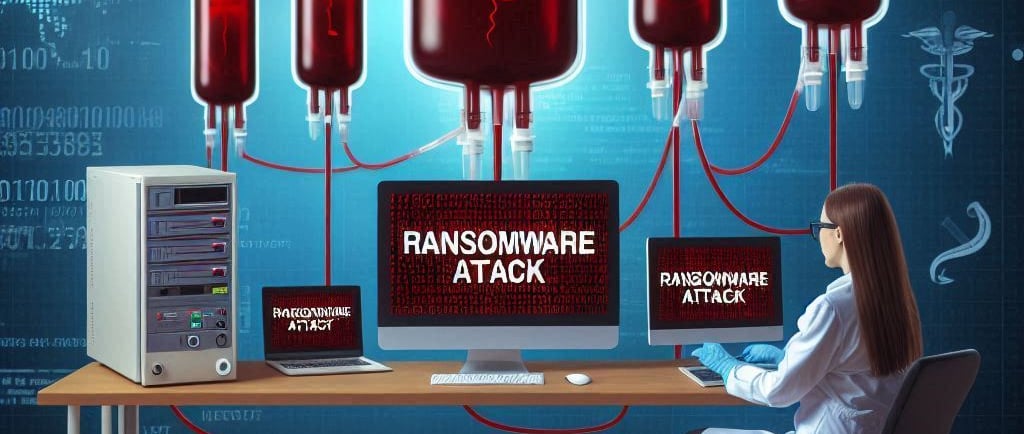Ransomware Attack on New York Blood Center
On January 26, 2025, the New York Blood Center Enterprises (NYBCE) faced a Ransomware attack, impacting blood donation services critical for healthcare. Learn how this incident affects blood supply and patient care in the New York metropolitan area.
RANSOMWARE ATTACK
3 min read
Ransomware Attack on New York Blood Center Enterprise (NYBCe)
On January 26, 2025, the New York Blood Center Enterprises (NYBCe), one of the largest independent, nonprofit blood collection and distribution organizations in the United States, which collects and distributes blood donations, was hit by a Ransomware attack. NYBCe plays a vital role in healthcare by providing blood and blood products to hospitals in the New York metropolitan area and beyond. The NYBC ensures a stable blood supply for surgeries, emergencies, and treatments for conditions like cancer, sickle cell disease, and trauma care. Here's what happened:
Suspicious Activity Detected: NYBCe noticed unusual activity in their IT systems and immediately brought in cybersecurity experts to investigate.
Ransomware Confirmed: The experts confirmed that the suspicious activity was due to a ransomware attack.
Systems Taken Offline: To contain the threat, NYBCe took some of their systems offline2. This caused delays in processing blood donations and led to the rescheduling of some blood drives.
Ongoing Restoration: NYBCe is working hard with cybersecurity experts to restore their systems as quickly and safely as possible. They don't have a specific timeline for when everything will be back to normal.
Community Response: Despite the disruption, NYBCe is still accepting blood donations, and the community has been very supportive.
This Ransomware attack came at a tough time because NYBCe had recently declared a blood emergency due to a drop in donations. They're doing everything they can to fix their systems and continue providing blood to hospitals.
What is Ransomware?
Ransomware is a type of malicious software (malware) that encrypts an organization's data, making it inaccessible until a ransom is paid to the attackers. Ransomware attacks often target sensitive data, disrupt operations, and can have severe consequences, especially for critical infrastructure like healthcare organizations.
Potential Impact of a Ransomware Attack on NYBC
The Ransomware attack on NYBCe could have the following consequences and could be severe:
Disruption of Blood Supply: Ransomware attack could disrupt the collection, testing, and distribution of blood products, potentially leading to shortages in hospitals. Delays in blood delivery could impact patient care, especially in emergencies.
Data Breach: Attackers might have already stolen sensitive data, including donor information (names, addresses, emials, medical histories), employee records, and financial data. This data could be leaked or sold on the dark web, leading to privacy violations and identity theft.
Operational Downtime: The NYBC's systems might be taken offline to contain the attack, slowing down operations and delaying critical services. Manual processes might need to be implemented, which are less efficient and prone to errors.
Financial Losses: The organization face ransom demands, recovery costs, and potential fines for data breaches or regulatory non-compliance. There might also be long-term financial impacts due to reputational damage and loss of donor trust.
Reputational Damage: Trust in the NYBC could be eroded, potentially affecting donor participation and partnerships with hospitals. Negative media coverage could further harm the organization's public image.
How Ransomware Attacks Typically Happen
Ransomware attacks often occur through:
Phishing Emails: Employees might inadvertently click on malicious links or download infected attachments.
Exploiting Vulnerabilities: Attackers exploit unpatched software or weak security configurations.
Third-Party Access: Compromised vendors or partners can provide an entry point for attackers.
Remote Desktop Protocol (RDP) Exploits: Weak or stolen credentials can allow attackers to gain access to systems.
Response to a Ransomware Attack
If the NYBC were targeted in 2025, the response might include:
Isolating Affected Systems: Disconnecting infected systems to prevent the ransomware from spreading.
Engaging Cybersecurity Experts: Working with cybersecurity firms to investigate the attack, remove the malware, and restore systems.
Notifying Authorities: Reporting the incident to law enforcement (e.g., FBI) and regulatory bodies (e.g., Department of Health and Human Services).
Communicating with Stakeholders: Informing donors, hospitals, and the public about the situation and its impact. Providing updates on recovery efforts and any potential risks.
Evaluating Whether to Pay the Ransom: Paying the ransom is generally discouraged, as it does not guarantee data recovery and may encourage further attacks. However, some organizations may consider it if critical systems or data are at risk.
Restoring Systems from Backups: If backups are available and unaffected, the NYBCe could restore its systems without paying the ransom.
Ransomware Attack Preventive Measures
To mitigate the risk of ransomware attacks, organizations like the NYBC typically implement:
Employee Training: Educating staff on recognizing phishing attempts and other threats.
Strong Cybersecurity Protocols: Using firewalls, antivirus software, and multi-factor authentication.
Incident Response Plans: Preparing for potential attacks to minimize damage and downtime.
Vulnerability Management: Regularly patching software and systems to address known vulnerabilities.
Regular Backups: Ensuring data can be restored without paying a ransom. One of the best ways to keep you system always backed up is CBackup which helps you to Sync all your Data to the Cloud. With a proper CBackup strategy, all free space of connected clouds can be combined into a huge, even an unlimited online backup space to store your backup files. Maximum budget savings.
CBackup - The Best Cloud Data Backup
Say NO to Data Loss
Cyber Security Threats
Malwarebytes Premium
Protect all your devices from all Malware and Viruses
© 2025. All rights reserved.


